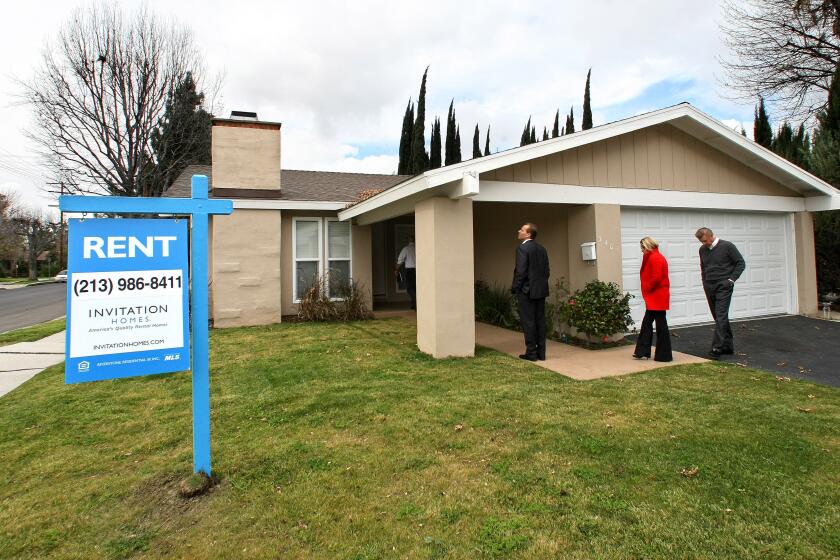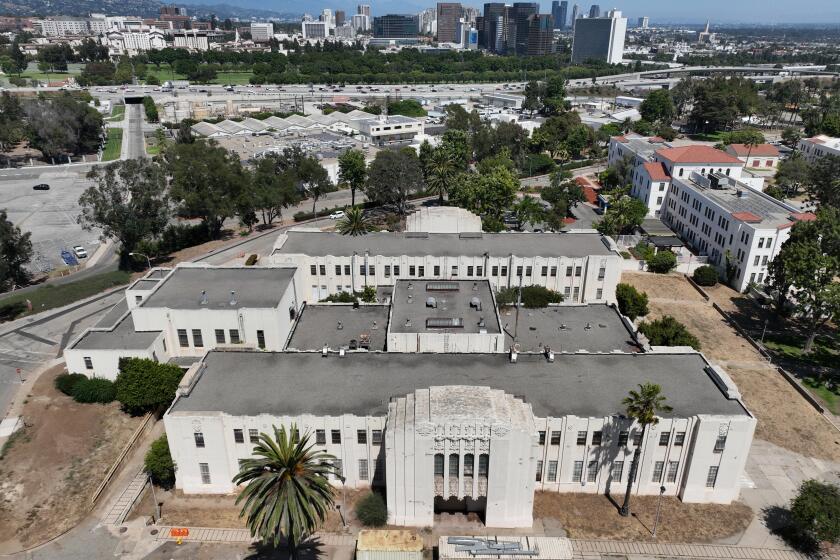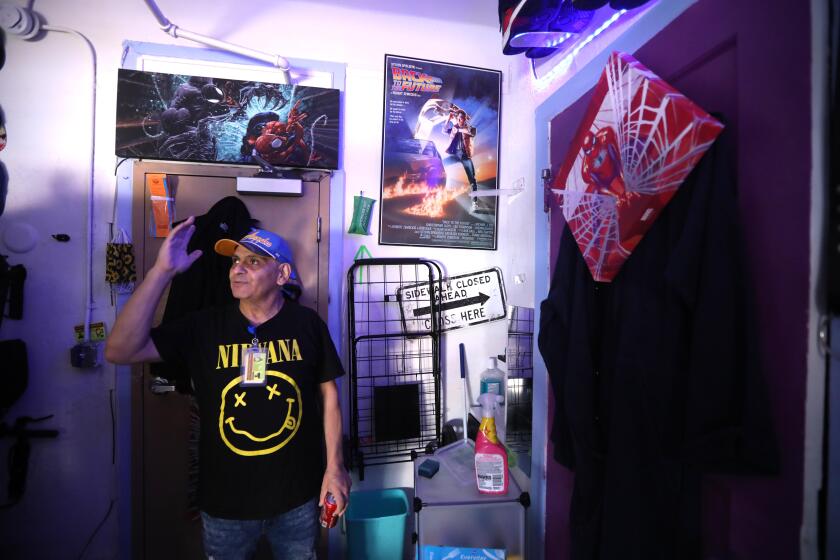Lancaster invests in vacant property
Elizabeth Brubaker strode up to a boarded-up abandoned home in Lancaster’s Piute neighborhood and enthusiastically rattled off the city’s plan to fix it up.
“We’ll go from asphalt to concrete,” said Brubaker, Lancaster’s director of housing and neighborhood revitalization, as she gestured toward the driveway. “We’ll do hardscape out front, so that we’re not utilizing water. But we’re going to leave in the trees. We’ll eliminate the wood siding and do block walls. And we’ll put in a roll-up garage.”
When renovation is complete, the home will be put up for sale to low- and moderate-income earners. The effort is part of a program to stem the deterioration of neighborhoods that have been slammed by the nation’s home foreclosure crisis.
While other cities are hoping for federal aid to help them address the problem, Lancaster is using city funds to buy, renovate and sell vacant homes. The need is clear.
In the first six months of this year, there were 3,518 foreclosures in the Antelope Valley’s largest cities of Lancaster and Palmdale, compared with 2,383 for all of 2007, according to statistics from the Greater Antelope Valley Economic Alliance.
More than 6,000 notices of default were issued to homeowners in the two cities from January through June -- almost matching the total of 6,372 for all of 2007.
Lancaster’s renovation of homes will go hand in hand with general infrastructure development, including road maintenance, Brubaker said.
“We’re trying to take all the tools in the toolbox to improve whole neighborhoods,” she said. “The ultimate goal is to make the city of Lancaster a place where people want to live, work, play and stay.”
So far, Lancaster’s Redevelopment Agency has agreed to spend more than $4.1 million to acquire and refurbish 41 homes. The city took ownership of the first six properties beginning in May.
Lancaster’s program began well ahead of a federal housing bill signed in July by President Bush that will award almost $4 billion in Community Development Block Grant funds to local governments to buy and rehabilitate foreclosed properties.
Los Angeles County does not have a program for reclaiming and fixing foreclosed homes. Housing activists in the city of Los Angeles have lobbied heavily for a share of the federal grant.
While they await federal funds, many Southern California cities are relying primarily on code enforcement to prevent neighborhoods from being blistered by blight.
In Palmdale, for example, an ordinance requires lenders to register properties on which they file foreclosure notices with the city, and keep them maintained and secure. Failure to comply could result in up to $2,500 in fines.
Temecula imposes similar registration rules for foreclosed properties. And in Grand Terrace in San Bernardino County, owners of rental properties pay an annual fee for a mandatory exterior inspection of their property.
Lancaster also promotes aggressive code enforcement. Within the last 2 1/2 years the number of code enforcement officers there has increased from three to 14.
But sometimes, the city has found, the best alternative is to take over a property and spruce it up. The city primarily targets foreclosed houses that are in extreme disrepair and have been vacant at least a year.
“The houses we are acquiring are the ones that have suffered the greatest amount of damage during the time they were owned,” Brubaker said.
Bob Schack, president of the Greater Antelope Valley Assn. of Realtors, said the city’s effort to buy mainly older, poorer-quality homes that had been languishing on the market was a “win-win” situation for all involved.
Realtors had generally been unsuccessful in moving such properties. But once the city renovates the houses, Realtors will help market and sell them, Schack said.
And the biggest winners, he said, would be the new homeowners, many of them first-time buyers. “Lancaster is being very proactive,” Schack said.
Mel Layne, president of the Greater Antelope Valley Economic Alliance, also gave the program a nod. “I’m not usually for government intervention in things,” he said. “But this is a good thing.”
Brubaker said deteriorating economic conditions demanded action by the city. “We had no other choice but to jump on [the problem] and do something,” she said.
Lancaster’s program mainly targets depressed neighborhoods. The city is paying between $80,000 and $110,000 for the properties and will accept bids from contractors to renovate them. Proposed repairs would include environment-friendly features such as drought-tolerant landscaping and tankless water heaters. When sold, the city hopes to recoup the price paid for each home, including the cost of renovation. But Brubaker said the goal is to keep the selling price reasonable for a family of four whose income does not exceed about $71,800 -- California’s average salary for qualifying for subsidized housing.
David Zapata Menchaca, the United Way of Los Angeles’ regional director of development for the Santa Clarita and Antelope valleys, said such housing opportunities are critical given the region’s other social and economic woes.
In the Antelope Valley, more than 7,400 people are homeless, 1 in 5 residents live in poverty, and 1 in 5 don’t have health insurance, Menchaca said. Lancaster would require the new owners to attend city-sponsored workshops on topics such as budgeting and home maintenance.
Local residents welcome the news.
Leah Kantin lives near an abandoned home that the city bought on Foxton Avenue. “It looks trashy,” said Kantin, 24, who shares her residence with her husband, stepmother and five children. Getting an occupant for the abandoned homes would help deter vagrants and kids from hanging around, Kantin added.
Community and business leaders also praised Lancaster’s program.
“It provides a sense of hope,” said Chris Johnson, senior pastor at Grace Chapel, which runs outreach activities in the Piute neighborhood.
“It tells people in these areas of town that they are valuable, and their quality of life is important to our community,” he said.
Inside the house on Foxton Avenue, Brubaker grimaced as she looked at the worn and dingy carpet, scarred with cigarette burns and stains.
“All the floor covering -- gone. We’ll put in new electrical fixtures, install smoke detectors, repair the drywall,” Brubaker said. She continued her inspection, rattling off what seemed a daunting list of repairs.
--
Sign up for Essential California
The most important California stories and recommendations in your inbox every morning.
You may occasionally receive promotional content from the Los Angeles Times.




